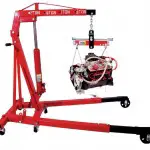We hope you love the products we recommend and just so you know that as an Amazon Associate EngineHoist.net may earn from qualifying purchases.
When it comes to lifting an engine out of a vehicle, using an engine hoist is the most efficient and safest method. However, knowing the best place to hook engine hoist chain can be a challenge, especially for those who are new to DIY mechanics. As someone who has worked on engines for years, I can tell you that the best place to hook engine hoist chain is the engine’s lifting points.
Table of Contents
What do Engine Lifting Points Look Like?
The lifting points on an engine are designed to to bear the weight of the engine, which makes them the safest and most stable locations to attach an engine hoist chain when removing or installing an engine. These points are spread out across the engine block and are typically located on the front and rear of the engine.
Attaching the engine hoist chain to these points ensures that the weight of the engine is evenly distributed and reduces the risk of damage to the engine or surrounding components.
Engine lifting points are generally sturdy, metallic loops or brackets that are securely bolted to the engine block. Their design can vary based on the make and model of the engine. Some engines may have obvious and designated lifting eyes or brackets which are circular or D-shaped and bolted onto the engine. Others may not have such explicit points, but there will still be areas, typically around the cylinder head or on the block, that are reinforced and intended to handle the weight of the engine during lifting.
Best Place to Hook Engine Hoist Chain
If you’re not sure where the lifting points are on a specific engine, it can be beneficial to refer to the engine or vehicle’s service manual, as this will often provide specific guidance. If you’re unsure and can’t find the information, it would be best to consult with a professional mechanic to avoid causing damage to the engine or the vehicle.
If you’re struggling to find the service manual for your vehicle, you could try looking here:
How to inspect the engine lifting points
- Examine the lifting points visually: Look for signs of damage, like cracks, bends, or things that don’t look right.
- Test the lifting points. If you can, carefully put a small amount of weight on the lifting points to see if they hold.
- If you are still not confident in the strength and durability of the lifting points, have a mechanic check them for you.
Types of Engine Hoist Chains
As someone who has used engine hoist chains for a while, I can tell you that there are different types of chains that you can use. In this section, I will discuss the different types of engine hoist chains available.
Chain Types
There are two types of chains that you can use for engine hoists: security chains and lifting chains.
Security Chains
Security chains are ¼” chains that have hooks on both ends and are meant to handle a 5-600-pound engine without any issue due to the 5,000 lbs. working strength. These chains are ideal for lifting engines that do not have loops for hooks. However, if your engine has loops for hooks, it is important to ensure that the hooks have security clips before using them to pull the engine.
Lifting Chains
Lifting chains are made from alloy steel and are designed to handle heavy loads. They are available in different sizes and lengths, and they come with different working load limits. When choosing a lifting chain, it is important to consider the weight of the engine that you will be lifting, as well as the length of the chain.
When using an engine hoist chain, it is important to ensure that the chain is in good condition and that it is rated for the weight of the engine that you will be lifting. Additionally, it is important to hook the chain to the engine’s lifting points to ensure that the weight of the engine is evenly distributed.
Selecting the Best Engine Hoist Chain
As someone who has worked with engine hoists for years, I know firsthand the importance of selecting the right chain. The chain is what holds the weight of the engine, so it’s crucial to choose one that is strong enough to handle the load and durable enough to last.
Factors to Consider
When selecting an engine hoist chain, there are several factors to consider. Here are some of the most important:
- Weight and Load Capacity: The chain you choose must be strong enough to handle the weight of the engine you’re lifting. Make sure to check the load capacity of the chain before using it.
- Durability: An engine hoist chain should be durable enough to withstand the weight of the engine and any other stresses that may be placed on it during the lifting process.
- Safety: Safety should always be a top priority when working with an engine hoist. Choose a chain that is designed for lifting heavy loads and has safety features such as hooks with security clips.
- Injury and Damage: Using the wrong chain can result in injury or damage to the engine or surrounding equipment. Make sure to choose a chain that is appropriate for the weight of the engine and the lifting process.
When selecting an engine hoist chain, it’s also important to consider the length and thickness of the chain. A chain that is too short may not be able to reach the lifting points on the engine, while a chain that is too thick may not fit through the lifting brackets.
In my experience, one of the best chains for engine lifting is a trailer security chain. These chains have hooks on both ends and are stout enough to handle a 5-600-pound engine without any issue due to the 5,000 lbs. working strength. However, unless your engine has loops for hooks (and the hooks have security clips), do not use the hooks to pull the engine.
Summary
In a nutshell, lifting an engine safely requires the right chain, attached to the right points. Use either security or lifting chains depending on your engine’s design, making sure they’re in good condition, and rated for the engine’s weight. Always hook to the engine’s lifting points for a balanced lift, reducing the risk of damage. Remember, safety is paramount, so take the time to choose the right equipment for your needs.









